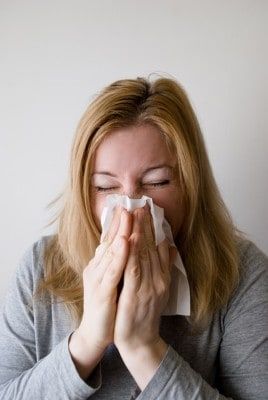The house dust allergy
It is estimated that in Germany ca. 10-12% of all residents have a house dust allergy. In fact, those affected are not allergic to house dust, but to dust mites and their excrement. But more about this below.
House dust allergy – symptoms: Sneezing, coughing and shortness of breath
With a house dust allergy, as with pretty much every allergy, the symptoms vary in severity. Some people have only mild symptoms, such as sneezing attacks (especially in the morning hours after waking up), red or itchy eyes and some coughing early in the morning. Other sufferers struggle with much worse symptoms.
In addition to sneezing fits, these sufferers often have a severe cough, severe itching and itchy eyes. Not infrequently, after some time a so-called change of floor takes place. This means that the allergy spreads to the bronchial tubes and the affected person can then get shortness of breath and asthma.
Causes of house dust allergy
As Kai Westermeier, the operator of the page house dust mites, told us.org told, the house dust allergy is not an allergy against dust.
In fact, the triggers are so-called house dust mites, which, microscopic, live in mattresses, blankets, upholstery, pillows and carpets.
A house dust allergy sufferer is allergic to these mites. Even worse than the mites themselves, however, is the mites’ droppings, which are made up of a high percentage of proteins.
When the excrement dries it disintegrates to dust. These fine dust particles (proteins) combine with the house dust. The allergy sufferer who inhales this house dust is allergic to the proteins in the mite excrement.
The term house dust allergy was therefore created by mistake, when people did not yet know about the existence of mites and thought that house dust itself triggered the allergy.
By the way: Do not be disgusted now. Dust mites have existed for as long as humans have lived in dwellings and are found practically everywhere in Europe. There is only one exception: from an altitude of 1500 m mites can not survive.
In the mountains, for example the Alps, they live therefore practically mite-free. Perhaps they consider that with your next vacation, if they belong to the house dust allergy sufferers.
People who are immunocompromised need to be especially careful with house dust allergy.
Fighting dust mites
For people who only complain of mild symptoms and discomfort, observance of a few points is sufficient: change bed linen frequently (preferably once a week) and wash at a temperature of at least 60°C.
Air the bedroom daily with the covers pulled back so that the mattress can also air out. Vacuuming several times a week with a vacuum cleaner that has a microfilter and also regular dusting, help significantly.
Affected persons, who suffer strongly from house dust allergy, should mite-proof covers buy for the mattress, the blanket and the pillow. These covers are called Encasings and are dust-, mite- and mite excrement-proof. One should wash these covers nevertheless regularly with 60°C.
Mite vacuum cleaner are special vacuum cleaners, which can kill and knock out the mites in the mattress via UV light and vibrations. Since they have very fine microfilters, the mites and mite feces that are sucked up remain safely stored in the mite vacuum cleaner. It is important that the mite vacuum cleaner is emptied by people without allergy if possible.
Mite sprays can also be bought in stores. Here you should check before use, whether there is not against these sprays themselves also an allergy, because this often happens.
Home remedies for allergies
In particular, who does not suffer quite so strongly from the house dust allergy, should trust in natural remedies and home remedies. There are a number of remedies that can relieve and help allergies.
Fresh nettle leaves, The tea, which is prepared and drunk two cups a day, is very effective in preventing allergic reactions. symptoms like itching or irritated mucous membranes can be prevented.
If the affected person suffers from itching and perhaps even a skin rash, a Bath with sea salt these complaints. Sea salt can be purchased in any better-stocked drug store.
The relatively unknown Butterbur is able to relieve cramps in the respiratory tract. Also against hay fever is used very successfully. For house dust allergy sufferers, who suffer from shortness of breath or asthma, butterbur is a good remedy.
Eyebright herb can be wonderfully used as a tea against red and itchy eyes. Let it cool down, soak a cotton ball with the tea and put it on the eyes. Eyebright herb is also available as eye drops under the name Euphrasia.
